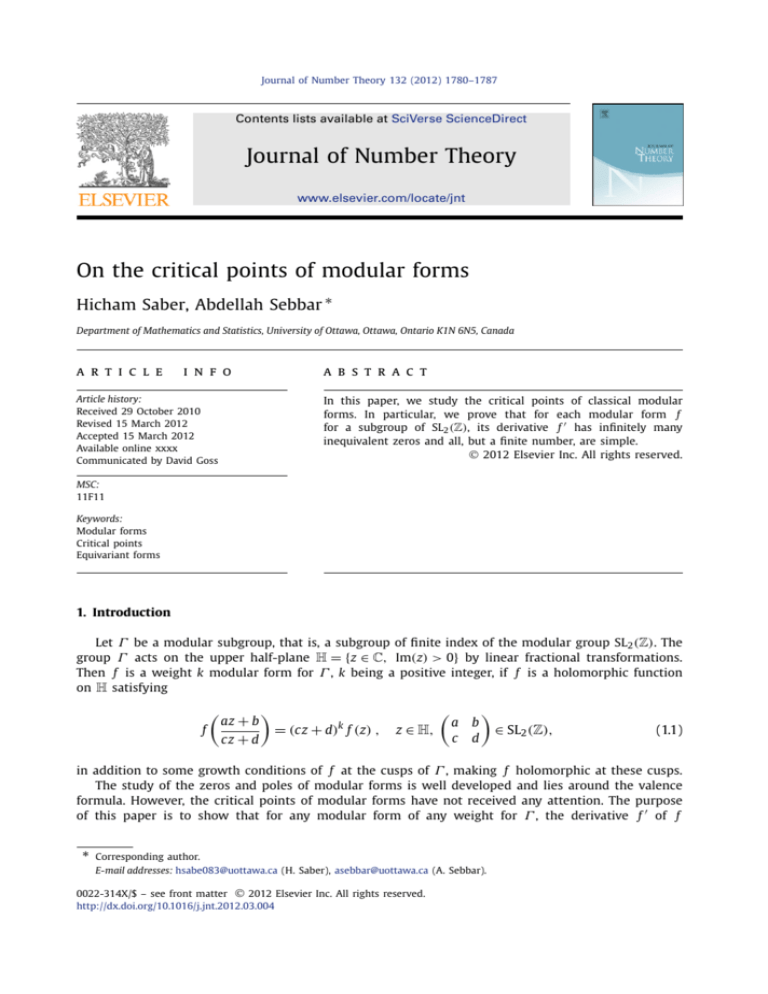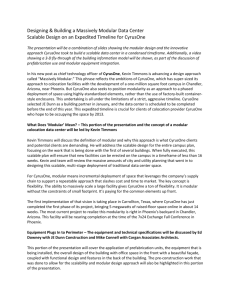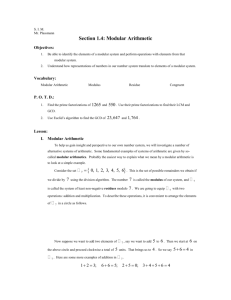
Journal of Number Theory 132 (2012) 1780–1787
Contents lists available at SciVerse ScienceDirect
Journal of Number Theory
www.elsevier.com/locate/jnt
On the critical points of modular forms
Hicham Saber, Abdellah Sebbar ∗
Department of Mathematics and Statistics, University of Ottawa, Ottawa, Ontario K1N 6N5, Canada
a r t i c l e
i n f o
a b s t r a c t
Article history:
Received 29 October 2010
Revised 15 March 2012
Accepted 15 March 2012
Available online xxxx
Communicated by David Goss
In this paper, we study the critical points of classical modular
forms. In particular, we prove that for each modular form f
for a subgroup of SL2 (Z), its derivative f has infinitely many
inequivalent zeros and all, but a finite number, are simple.
© 2012 Elsevier Inc. All rights reserved.
MSC:
11F11
Keywords:
Modular forms
Critical points
Equivariant forms
1. Introduction
Let Γ be a modular subgroup, that is, a subgroup of finite index of the modular group SL2 (Z). The
group Γ acts on the upper half-plane H = { z ∈ C, Im( z) > 0} by linear fractional transformations.
Then f is a weight k modular form for Γ , k being a positive integer, if f is a holomorphic function
on H satisfying
f
az + b
cz + d
= (cz + d)k f ( z) ,
z ∈ H,
a b
c d
∈ SL2 (Z),
(1.1)
in addition to some growth conditions of f at the cusps of Γ , making f holomorphic at these cusps.
The study of the zeros and poles of modular forms is well developed and lies around the valence
formula. However, the critical points of modular forms have not received any attention. The purpose
of this paper is to show that for any modular form of any weight for Γ , the derivative f of f
*
Corresponding author.
E-mail addresses: hsabe083@uottawa.ca (H. Saber), asebbar@uottawa.ca (A. Sebbar).
0022-314X/$ – see front matter © 2012 Elsevier Inc. All rights reserved.
http://dx.doi.org/10.1016/j.jnt.2012.03.004
H. Saber, A. Sebbar / Journal of Number Theory 132 (2012) 1780–1787
1781
has infinitely many zeros that are inequivalent relative to Γ . In fact, infinitely many such zeros lie
within a vertical strip of width equal to the cusp width at infinity for Γ . Moreover, all but a finite
number of these zeros are simple. In fact, the multiple zeros happen to be the zeros of an auxiliary
modular form constructed using the Rankin–Cohen bracket and thus there is only a finite number
of equivalence classes of such multiple zeros. The main result is a generalization of a result in [3],
where it is shown that the Eisenstein series E 2 has infinitely many inequivalent zeros which are also
the zeros of the derivative of the discriminant cusp form .
Our main tool is the equivariance of the function
f ( z)
,
h ( z) = z + k f ( z)
where f is a modular form of weight k. Indeed, the function h has the intriguing property that it
commutes with the action of Γ . Using classical theorems from complex analysis such as the Schwarz
lemma and the theorem of Denjoy–Wolff, we will prove that in fact h has infinitely many inequivalent
poles in H.
It should be noted that some ideas in Section 3 were inspired from the work of M. Heins [4]. In this
paper a particular function commuting with the action of the modular group has been constructed
as the quotient of two pseudo-periods of the Weierstrass ζ -function. However, the proofs of these
results in Section 3 are made much simpler since we deal only with modular subgroups and thus
avoiding the intricate geometry of a general Fuchsian group of the first kind.
The paper is organized as follows: In Section 2, we attach, to each modular form, an equivariant
function that commutes with the action of the modular subgroup. In Section 3, we study mapping
properties of the equivariant functions with the aim that if such equivariant function is not the identity, then the image of the upper half-plane must meet the real line. In Section 4, we prove the main
result of this paper that the derivative of every modular forms has infinitely many inequivalent zeros
in the upper half-plane. We also provide an interesting application about the vanishing of the Fourier
coefficients of modular forms. In Section 5, we extend the main result to the case of quasimodular
forms of weight 2 and depth 1 having monomial quasimodular polynomial. Finally, in the last section,
we study few examples involving Eisenstein series and theta functions.
2. From modular forms to equivariant functions
While, for most of this note, the group Γ can be any discrete group commensurable with the
modular group, we will suppose, for the sake of clarity, that Γ is a modular subgroup. Let f be a
modular form for Γ of weight k, k 0. We attach to f a meromorphic function
f ( z)
.
h ( z) = h f ( z) = z + k f ( z)
(2.1)
We have:
Proposition 2.1. (See [9,8].) The function h( z) satisfies
h(γ · z) = γ · h( z) for all γ ∈ Γ, z ∈ H.
(2.2)
This important statement follows from a straightforward calculation. A complete classification of
all functions satisfying the relation (2.2) as well as many of their properties is carried out in [8]
and [2]. Following [8], we call such function an equivariant function for Γ . If k = 0, that is f is a
modular function, then h( z) = h0 ( z) := z.
Proposition 2.2. Let Γ be a modular subgroup, then the only Möbius transformation that is equivariant for Γ
is h0 ( z).
1782
H. Saber, A. Sebbar / Journal of Number Theory 132 (2012) 1780–1787
1 1
1 0
Proof. Let T =
and S =
. Since Γ has finite index in SL2 (Z), and since T and S have
01
11
infinite orders, a certain power T n of T and a certain power S m of S must belong to Γ . If h( z) = γ · z,
γ ∈ GL2 (C), is equivariant, then γ must commute
with all the elements of Γ . In particular, if γ
λ 0
commutes with both T n and S m , then γ =
, λ ∈ C, that is, h( z) = h0 ( z) = z. 2
0λ
3. Mapping properties
In the following, we will study the image of the upper half-plane H under an equivariant function h. The ultimate goal is to show that if h = h0 is holomorphic, then h(H) ∩ R is not empty.
Proposition 3.1. Let h = h0 be a holomorphic equivariant function for a modular subgroup Γ such that h
maps the upper half-plane H to itself. If h has a fixed point z0 , then it is unique.
Proof. Let M be a Möbius transformation that maps H conformally onto the unit disc D such that
M ( z0 ) = 0. The map g = MhM −1 : D → D is a holomorphic map such that g (0) = 0. If h has another
fixed point z1 = z0 in H, it will correspond to a nonzero fixed point of g in D. Using the Schwarz
lemma, we must have g ( z) = λ z, and thus h( z) is a Möbius transformation. According to Proposition 2.2, we must have h( z) = h0 ( z) = z which is excluded by assumption. 2
Proposition 3.2. Let h = h0 be a holomorphic equivariant function for a modular subgroup Γ such that h
maps the upper half-plane H to itself. Then h does not have a fixed point in H.
Proof. Let us assume that there exists z0 ∈ H such that h( z0 ) = z0 . For γ ∈ Γ , we have h(γ · z0 ) =
γ · h(z0 ) = γ · z0 and hence γ · z0 is also a fixed point of h. Therefore, using Proposition 3.1, γ · z0 = z0
for all γ ∈ Γ , which is impossible if one takes γ = T n , a power of the translation T that belongs
to Γ . Thus, h cannot have a fixed point in H. 2
Proposition 3.3. Let h be a holomorphic equivariant function for a modular subgroup Γ mapping the upper
half-plane H to itself, then h( z) = h0 ( z) = z.
Proof. Let us assume that h = h0 . Then, using Proposition 3.2, h does not have a fixed point in H. As
above, let M be a Möbius transformation that maps H conformally onto the unit disc D. The map g =
MhM −1 : D → D is a holomorphic map. According to the theorem of Denjoy–Wolff, [1], g is either a
conformal rotation about some fixed point z0 , or the successive iterates gn = g ◦n converge, uniformly
on compact subsets of D, to a constant function z → c 0 ∈ D̄. The former situation is excluded since
g does not have a fixed point. It follows that the holomorphic maps hn = h◦n : H → H also converge
to a constant function z → c 1 = M −1 c 0 . Suppose c 1 = ∞ and let n0 be a positive integer such that
T n0 is in Γ . Since the functions hn are also equivariant, we have hn ( z + n0 ) = hn ( z) + n0 . For a fixed
z ∈ H, taking n to infinity yields c 1 = c 1 + n0 which is a contradiction since n0 > 0. If c 1 = ∞, let
n1 be a positive integer such that S n1 ( z) = z/(n1 z + 1) is in Γ . For a fixed z ∈ H, taking n to ∞ in
hn ( S n1 z) = S n1 hn ( z) yields a contradiction since n1 > 0. 2
We shift our attention to the case when an equivariant function maps the upper half-plane to the
lower half-plane H− .
Proposition 3.4. An equivariant function for a modular subgroup Γ cannot map the upper half-plane H to
the lower half-plane H− .
Proof. Suppose that such h exists. We extend h to a mapping h̃ defined on H ∪ H− by setting h̃( z) =
h( z) for z ∈ H− . Then the restriction of h̃ ◦ h̃ maps H to H and it is equivariant for Γ . According to
Proposition 3.3, we must have h̃ ◦ h̃( z) = z. This, in particular, implies that h( z) is bijective. Therefore,
the function g ( z) = 1/h( z) is an automorphism of H and so is an element of PSL2 (R). Therefore h
H. Saber, A. Sebbar / Journal of Number Theory 132 (2012) 1780–1787
1783
is a Möbius transformation that is equivariant. According to Proposition 2.2, h( z) = h0 ( z). This is a
contradiction since h0 is supposed to map H to H− . 2
4. Critical points of modular forms
In this section we prove that for any nonzero modular form f of positive weight k for a modular
subgroup Γ , the derivative f has infinitely many zeros in H that are inequivalent relative to Γ .
We recall that, using the valence formula for modular forms, f has only kμ/12 inequivalent zeros
counted with multiplicity where μ = [SL2 (Z) : Γ ].
Theorem 4.1. If f is a nonzero modular form of weight k > 0 for a modular subgroup Γ , then f has infinitely
many zeros in H that are inequivalent relative to Γ .
Proof. Let f be such a modular form. The equivariant function
f ( z)
h ( z) = z + k f ( z)
satisfies h( z) = h0 ( z). Moreover, there exists z0 ∈ H such that h( z0 ) ∈ R. Indeed, if h has a pole z, then
for any γ ∈ Γ not a translation,
h(γ · z) = γ · h( z) = γ · ∞ ∈ Q.
On the other hand, if h( z) is holomorphic in H, then by Proposition 3.3 h(H) is not contained in
H and by Proposition 3.4, h(H) is not contained in H− . Since h(H) is connected, we must have
h(H) ∩ R = ∅. In either case, there is always z0 ∈ H at which h takes a real value. In fact, z0 cannot be
an elliptic fixed point for Γ , otherwise, there exists an elliptic element γ ∈ Γ such that γ · z0 = z0 ,
and hence h( z0 ) is also fixed by γ and thus h( z0 ) = z0 or h( z0 ) = z0 and so it is not real. We can
choose a small open disc D around h( z0 ) such that V = h−1 ( D ) is an open neighborhood of z0 not
containing any elliptic fixed point, and such that no two points of V are Γ -equivalent. The disc D
meets R in an open interval I . Meanwhile, since Γ has finite index in SL2 (Z), each orbit of a cusp
for Γ is dense in R and hence in the interval I . In particular, there are infinitely many rational points
that are Γ -equivalent to the cusp ∞. Let r ∈ I be such a rational number with r = h( z), z ∈ V , and let
γ ∈ Γ such that γ · r = ∞. Then γ · z is a pole of h. Indeed,
h(γ · z) = γ · h( z) = γ · r = ∞.
In fact, the point γ · z is a zero of f ( z). Furthermore, no two zeros γ1 · z1 and γ2 · z2 of f ( z) thus
constructed are Γ -equivalent because this would imply that z1 and z2 , which are both in V , are
Γ -equivalent and this is not the case by construction of V . Therefore, f (z) has infinitely many zeros
in H that are inequivalent relative to Γ . 2
Remark 4.2. Since f ( z) is invariant under the translations that are in Γ , it is clear that f ( z) has
infinitely many inequivalent zeros in the vertical strip −l/2 < Re z l/2 where l is the cusp width at
1 n
infinity defined to be the smallest positive integer n such that
∈Γ.
01
As for the multiplicity of the zeros of f , we have:
Proposition 4.3. If f is a nonzero modular form for a modular subgroup Γ , then f has only a finite number
of inequivalent multiple zeros.
1784
H. Saber, A. Sebbar / Journal of Number Theory 132 (2012) 1780–1787
Proof. If f has weight k, then one can easily show that F ( z) = kf f − (k + 1) f 2 is a modular form
of weight 2k + 4. Now, suppose that z0 is a multiple zero of f , then f ( z0 ) = 0 and hence F ( z0 ) = 0.
However, F ( z), being a modular form, has only finitely many inequivalent zeros. The proposition
follows. 2
Remark 4.4. The form F ( z) introduced in the above proof is an example of the so-called Rankin–
Cohen bracket [10]. In fact (k + 1) F ( z) = [ f , f ]2 , the bracket of order 2. For a modular form f of
weight k and a modular form of weight l, the Rankin–Cohen bracket of order n 0 is defined by
[ f , g ]n =
n
k + n − 1 l + n − 1 (r ) (n−r )
(−1)r
f g
.
n−r
r
r =0
It defines a modular form of weight k + l + 2n.
We end this section with an interesting application. If f is a modular form of weight k for a
modular subgroup Γ and if l is the cusp width at ∞, then f has the following q-expansion, where
q = exp 2π iz/l
f ( z) =
an qn ,
an ∈ C.
nn0
As a corollary of the results of this section, we have the following:
Theorem 4.5. If f is a nonzero modular form for a modular subgroup Γ , then infinitely many of the q-coefficients an are nonzero.
Proof. If f is polynomial in q, so is f . Moreover, there are infinitely many inequivalent zeros to f in the vertical strip −l/2 < Re z l/2 yielding infinitely many different values of q that are roots of
f (q) which is a contradiction. Therefore, f cannot be polynomial in q. 2
In fact, this is a classical theorem for which a proof can be found in [6] using the Rankin–Selberg
zeta function attached to f or using the theory of vector-valued modular forms.
5. Quasimodular forms
In this section we establish a similar result for quasimodular forms. They were introduced by
M. Kaneko and D. Zagier in [5] as a generalization of modular forms. A holomorphic function f on H
is called a quasimodular form of weight k and depth p for a modular subgroup Γ if it satisfies
(cz + d)−k f (γ · z) =
p
f i ( z)
i =0
c
cz + d
i
,
γ ∈ Γ, z ∈ H,
(5.1)
where each f i is a holomorphic function of H. The quasimodular polynomial attached to f is defined
by
p
F k ( z, X ) :=
p
f i ( z) X i .
i =0
Setting
γ = I 2 , the identity matrix, in (5.1) shows that f 0 = f .
(5.2)
H. Saber, A. Sebbar / Journal of Number Theory 132 (2012) 1780–1787
1785
We focus on the quasimodular forms of weight 2 and depth 1, and in particular on those whose
quasimodular polynomial is monomial, that is, of the form
F 21 ( z, X ) = f 0 ( z) + X .
(5.3)
Example of such quasimodular form is given by
φ0 ( z ) =
πi
6
E 2 ( z),
where E 2 is the Eisenstein series given by:
E 2 ( z) = 1 − 24
∞
σ1 (n)qn
n =1
where σ1 (n) is the sum of the positive divisors of n. In fact φ0 is a quasimodular form for SL2 (Z) as
well as for any of its subgroups. We have
Proposition 5.1. (See [2].) Let f be a quasimodular form for a modular subgroup Γ with a quasimodular
polynomial given by (5.3). Then the function
h ( z) = z +
1
f ( z)
is equivariant for Γ .
Proof. This follows from a straightforward calculations.
2
As in the previous section we deduce
Corollary 5.2. Every quasimodular form for a modular subgroup Γ with a quasimodular polynomial as in
(5.3) has infinitely many zeros that are inequivalent relative to Γ .
There is a different way to look at the above result. As it was mentioned above, according to the
valence formula for modular forms, the number of inequivalent zeros of f counted with multiplicity
is 2μ/12 where μ is the index of Γ in SL2 (Z). However if we perform a perturbation to f by a fixed
quasimodular form as above, e.g. by φ0 , then we have the following:
Proposition 5.3. Let φ0 = (π i /6) E 2 and let f be any modular form of weight 2 for a modular subgroup Γ ,
then f + φ0 has infinitely many zeros that are inequivalent relative to Γ .
Proof. If f is a weight 2 modular form for Γ , and if φ is a quasimodular form for Γ with a quasimodular polynomial as in (5.3), then f + φ is also a quasimodular form for Γ with the quasimodular
polynomial having the same shape as in (5.3). The proposition follows from Corollary 5.2. 2
Remark 5.4. The results of Sections 4 and 5 are still valid for meromorphic modular forms and
meromorphic quasimodular forms and also for modular forms with a multiplier system since the
equivariance of (2.1) remains valid in these cases [2]. Moreover, the weight of the modular forms
under consideration can be any positive real number, and not necessary an integer.
1786
H. Saber, A. Sebbar / Journal of Number Theory 132 (2012) 1780–1787
6. Examples
In this section we provide few examples involving the Eisenstein series and the Jacobi theta functions. The main reference for the formulas below is [7]. We recall the following:
E 2 ( z) = 1 − 24
∞
σ1 (n)qn ,
n =1
∞
E 4 ( z) = 1 + 240
σ3 (n)qn ,
n =1
∞
E 6 ( z) = 1 − 504
σ5 (n)qn .
n =1
The Eisenstein series E 4 and E 6 are modular forms for SL2 (Z) of weight 4 and 6 respectively, and E 2
is a quasimodular form of weight 2 and depth 1. Moreover, E 2 satisfies
E 2 ( z) =
1 ( z )
2π i ( z)
(6.1)
,
where is the weight 12 cusp form for SL2 (Z) given by
( z) = q
1 − qn
24
.
n1
The Eisenstein series satisfy the Ramanujan relations
6
πi
E 2 = E 22 − E 4 ,
(6.2)
3 E = E4 E2 − E6,
2π i 4
1 E = E 6 E 2 − E 42 .
πi 6
(6.3)
(6.4)
The Jacobi theta functions are given by
θ2 ( z) =
∞
q(n+1/2) ,
2
n=−∞
θ3 ( z) =
∞
2
qn ,
n=−∞
θ4 ( z) =
∞
2
(−1)n qn .
n=−∞
These theta functions are modular forms of weight 1/2 with multiplier systems for conjugates of the
level 2 congruence subgroup Γ (2).
As a consequence of Corollary 5.2, the Eisenstein series E 2 (and hence ) has infinitely many
zeros in the strip −1/2 < Re( z) /12. Moreover, all these zeros are simple since E 2 and E 2 cannot
H. Saber, A. Sebbar / Journal of Number Theory 132 (2012) 1780–1787
1787
vanish at the same time because of (6.2) and the fact that E 4 vanishes only at the orbit of the cubic
root of unity ρ . Similarly, the zeros of E 4 are also simple because of (6.3) and the fact that E 6 vanishes
only at the orbit of i. Using the same argument and (6.4), the zeros of E 6 are all simple. We also note
that E 2 is real on the axis Re( z) = 0 and Re( z) = 1/2, and one can show that it has a unique zero
on each axis given approximately by i0.5235217000 and 1/2 + i0.1309190304. Also, E 4 and E 6 are
purely imaginary on both axes and have (unique) zeros only on Re( z) = 1/2 given respectively by
1/2 + i0.4086818600 and 1/2 + i0.6341269863.
As for the theta functions, we have the following relations:
ϑ2 ( z) = 2
ϑ3 ( z) =
η(4z)2
,
η(2z)
η(2z)5
,
η(z)2 η(4z)2
ϑ4 ( z) =
η(z)2
,
η(2z)
where the Dedekind eta function is given by η( z) = ( z)1/24 . One can see that the three theta functions are infinite products and thus do not vanish in H. Using (6.1), we have the following formulas
for the derivative of the theta functions:
1 θ2 ( z)
= 4E 2 (4z) − E 2 (2z),
(6.5)
= 5E 2 (2z) − E 2 ( z) − 4E 2 (4z),
(6.6)
4π i θ2 ( z)
24 θ3 ( z)
π i θ3 (z)
1 θ4 ( z)
2π i θ4 ( z)
= E 2 ( z) − E 2 (2z).
(6.7)
It is interesting to notice that each of the above combinations with E 2 , E 4 and E 6 vanishes infinitely
many times at inequivalent points in a vertical strip in H.
References
[1] Lennart Carleson, Theodore Gamelin, Complex Dynamics, Springer-Verlag, New York, 1993.
[2] Abdelkrim El Basraoui, Abdellah Sebbar, Equivariant forms: structure and geometry, Canad. Math. Bull., in press,
http://dx.doi.org/10.4153/CMB-2011-195-2.
[3] Abdelkrim El Basraoui, Abdellah Sebbar, Zeros of the Eisenstein series E 2 , Proc. Amer. Math. Soc. 138 (7) (2010) 2289–2299.
[4] Maurice Heins, On the pseudo-periods of the Weirstrass zeta-function. II, Nagoya Math. J. 30 (1967) 113–119.
[5] Masanobu Kaneko, Don Zagier, A generalized Jacobi theta function and quasimodular forms, in: The Moduli Space of Curves,
in: Progr. Math., vol. 129, Birkhäuser Boston, Boston, MA, 1995, pp. 165–172.
[6] Winfried Kohnen, Geoffrey Mason, On generalized modular forms and their applications, Nagoya Math. J. 192 (2008) 119–
136.
[7] Robert Rankin, Modular Forms and Functions, Cambridge Univ. Press, Cambridge, 1977.
[8] Abdellah Sebbar, Ahmed Sebbar, Equivariant functions and integrals of elliptic functions, Geom. Dedicata, in press,
http://dx.doi.org/10.1007/S10711-011-9688-7.
[9] John Smart, On meromorphic functions commuting with elements of a function group, Proc. Amer. Math. Soc. 33 (1972)
343–348.
[10] Don Zagier, Elliptic modular forms and their applications, in: The 1-2-3 of Modular Forms, in: Universitext, Springer, Berlin,
2008, pp. 1–103.







